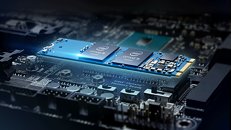Tuesday, February 21st 2017

Intel Launches Site Detailing Optane Requirements: Skylake Users Need Not Apply
Microprocessor giant Intel has launched a new page dedicated to its 3D XPoint-based Optane memory solution, a technology that it jointly developed with memory manufacturer Micron back in 2015, and was supposed to be on the market by 2016. The company missed that date; however, the technology is still interesting to enthusiasts and power users alike, due to its promises of both high speed and large capacity, a seemingly unattainable combo in today's markets.
Unfortunately, it seems that any system built around when Optane was announced will not be able to run Optane-based SSDs. In the system requirements section of its page, Intel has indicated that Optane will not run on anything earlier than a Kaby Lake based CPU. No exceptions. Yes, that includes Skylake, Broadwell, and pretty much everything else besides Kaby Lake. You will also need a 200-series chipset or newer.Skylake is amongst the most surprising of these exclusions, because it is nearly identical architecture-wise to Kaby Lake and a Skylake based chip was once used in a Optane test demonstration.
Sources:
Intel, bit-tech
Unfortunately, it seems that any system built around when Optane was announced will not be able to run Optane-based SSDs. In the system requirements section of its page, Intel has indicated that Optane will not run on anything earlier than a Kaby Lake based CPU. No exceptions. Yes, that includes Skylake, Broadwell, and pretty much everything else besides Kaby Lake. You will also need a 200-series chipset or newer.Skylake is amongst the most surprising of these exclusions, because it is nearly identical architecture-wise to Kaby Lake and a Skylake based chip was once used in a Optane test demonstration.

33 Comments on Intel Launches Site Detailing Optane Requirements: Skylake Users Need Not Apply
Can't wait for Ryzen to give Intel a kicking.
www.techpowerup.com/forums/threads/intel%E2%80%99s-hedt-core-i7-7000-skylake-x-and-kaby-lake-x-details-leaked-%E2%80%93-launching-in-august-2017.230943/#post-3606834
It appears Intel are just rushing something out to compete with AMD in the interim.
And, the difference in ipc between skylake and broadwell-e won't help with what AMD is going to put out... Unless they process it accordingly...which I doubt.